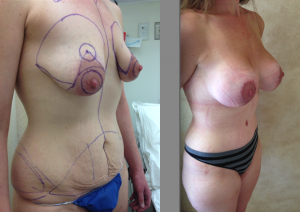Areolar Reduction
Posted On: October 14, 2016 Author: The Office of Dr. Stuart Linder Posted In: Areolar Reduction
 Patients who undergo both formal mastopexies as well as breast reduction procedures usually will have a reduction in the areolar size. In general, areolas are made between 3.8 and 4.4 cm in size. I prefer to make them approximately 4.2 cm or 42 mm.
Patients who undergo both formal mastopexies as well as breast reduction procedures usually will have a reduction in the areolar size. In general, areolas are made between 3.8 and 4.4 cm in size. I prefer to make them approximately 4.2 cm or 42 mm.
We have what are referred to as cookie cutter patterns in the three sizes, 38, 42, 44 to 46 mm. I use 4.2 cm cookie cutter patterns on both my breast lifts and breast reduction procedures in the majority of cases. The areolar reduction is considered a part of a breast reduction or breast lift procedure if the areolar is enlarged. Areola enlargement can be seen as large as 8 to 10 cm on large women’s breasts who undergo large reduction mammoplasties or women who have had significant stretching of the breast tissue after breast feeding or postpartum. As a result, the areolar reduction can be made with skin removed in a circumferential fashion around the areola.
Areolar Reduction Techniques
Different techniques can be performed, including the round block or Benelli technique, which is simply an areolar reduction with skin removed circumferentially as in a donut mastopexy. This, however, has significant problems with stretching of the scars, widespread scars and pin cushioning which can look very, very poor. Scarring, in other words, can be very poor with the Benelli lift. As a result, I prefer not to use this approach whenever possible. A vertical mastopexy can be performed where skin is removed along the vertical plane and around the areola which will reduce the tension around the nipple areolar complex, bringing it below the 6 o’clock position of the areolar down along the vertical or midline plane of the breast. This helps to dissipate tension from the areolar scar and the results I have found to be much better in general.
Finally, a formal mastopexy using the inferior pedicle Wise-pattern technique can be performed in an anchor scar-like fashion, where the skin is removed again around the areola vertically and along the inframammary fold. This greatly reduces scarring, stretching and tension along the nipple areolar complex and has led to beautiful scarring around the nipple areolar complex.
In our practice we use Kelo-cote once the sutures are removed, usually on day 14 to 17. The Kelo-cote silicone gel spray or cream can be used twice a day for three to six months which greatly reduces scarring, spreading, hyperpigmentation and telangiectasias and blood vessels within the scar.